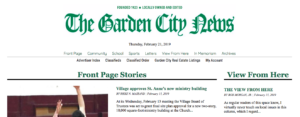 Statutorily required notice goes by a number of different names. There’s “public notice”, of course. “Legal notice” is a big one. “Legal ads” is also used quite often. And then there’s plain old “legals”, as in “the legals”.
Statutorily required notice goes by a number of different names. There’s “public notice”, of course. “Legal notice” is a big one. “Legal ads” is also used quite often. And then there’s plain old “legals”, as in “the legals”.
Ask someone in the newspaper business what they’re called and you may get any one of those answers. Ask someone outside the newspaper business the same question and the response is likely to be, “Huh?”
There are a number of reasons for the public confusion over public notice advertising, including the fact that the newspaper industry can’t agree on a name for them. Branding 101 would suggest that’s a problem.
Two newspapers that get creative with notice
Print circulation has been declining for years, so newspapers must become creative if they expect to continue to attract eyeballs to their public notice ads.
In Ketchum, Idaho, the Idaho Mountain Express has for many years maintained a pretty simple strategy for drawing attention to their public notices: The 45-year-old newspaper publishes a “Cliff Notes” summary of notices in the news section of its print edition (see graphic below); the summary points readers to the complete, official notices published in its “local life” section. The Mountain Express also publishes the summary in its e-edition along with instructions for where readers can find the official public notices in the print issue and online.
Unusual legislative maneuvers worry Texas newspapers
 The Texas Press Association (TPA) had a challenging year in the legislature. In this case, “challenging” isn’t deployed as a euphemism to describe a poor outcome. It’s used in its traditional sense to describe a situation that was demanding and arduous.
The Texas Press Association (TPA) had a challenging year in the legislature. In this case, “challenging” isn’t deployed as a euphemism to describe a poor outcome. It’s used in its traditional sense to describe a situation that was demanding and arduous.
Texas legislators introduced 7,324 bills in the state’s 2019 biennial session that ended in late May. TPA was tracking 220 of them, including 60 that related directly or tangentially to public notice. Executive Vice President Donnis Baggett describes the session as “hellacious”.
Hog farm saga comes to an end
 In December 2012, residents of Newton County, Arkansas were surprised to see a hog farm being built on the banks of Big Creek, a tributary on the Buffalo National River. The state’s Department of Environmental Quality (ADEQ) had approved a permit for C&H Hog Farms to operate the Concentrated Animal Feeding Operation (CAFO). Notice about the farm was published that summer on ADEQ’s website but not in a local newspaper.
In December 2012, residents of Newton County, Arkansas were surprised to see a hog farm being built on the banks of Big Creek, a tributary on the Buffalo National River. The state’s Department of Environmental Quality (ADEQ) had approved a permit for C&H Hog Farms to operate the Concentrated Animal Feeding Operation (CAFO). Notice about the farm was published that summer on ADEQ’s website but not in a local newspaper.
Several years of lawsuits and increased environmental activism followed.
As legislatures adjourn for the year, newspaper notice as strong as ever
We’ve heard dire warnings for many years that public notice would soon be moving from newspapers to the internet. Yet here we are, twenty years after the pessimists first began predicting doom, and newspapers are still the primary vehicle for official notice in all 50 states.
 And after several mostly successful years defending public notice in state legislatures, the newspaper industry is faring especially well on that front in 2019. With 33 legislative bodies already shuttered for the year and eight others scheduled to adjourn sine die by the end of the month, the third leg of the government-transparency stool is looking pretty stable.
And after several mostly successful years defending public notice in state legislatures, the newspaper industry is faring especially well on that front in 2019. With 33 legislative bodies already shuttered for the year and eight others scheduled to adjourn sine die by the end of the month, the third leg of the government-transparency stool is looking pretty stable.
In year of heightened legislative activity, Arkansas and Virginia score big wins
 We’re only four months into the year and more public notice bills* have already been enacted than in all of 2018.
We’re only four months into the year and more public notice bills* have already been enacted than in all of 2018.
Like 2018, the truly bad bills — the existential threats to newspaper notice — are either going nowhere or have already been defeated. The two state press groups that appeared to face the greatest danger — Missouri Press Association and Hoosier State Press Association, both of which fought bills that would have eliminated newspaper notice of foreclosure sales — survived to fight another day. Indiana HB1212 passed the House but died in the Senate when the legislature adjourned last week. Missouri HB686/SB50 hasn’t managed to make it out of committee in either chamber with only two weeks left in the session even though an almost-identical piece of legislation came dangerously close to passage in 2018.
Foreclosure notices at issue in Midwestern states
A bill that would have eliminated the newspaper publication requirement for foreclosure notices in Indiana was narrowly defeated last week in a vote taken immediately following a committee hearing.
House Bill 1212 had passed the Indiana House 62-34 in January and was in danger of moving another step closer to passage when it was defeated by a vote of 5-4 in the Senate Local Government Committee.
Missouri papers take the offensive; unusual notice bills introduced in Idaho and West Virginia
 Newspapers in Missouri are going on the offensive in their battle to save public notice in their state.
Newspapers in Missouri are going on the offensive in their battle to save public notice in their state.
Fighting separate bills that would move all government and foreclosure notice in the state from newspapers to government and law-firm websites, the Missouri Press Association (MPA) threw its support behind Senate Bill 515, introduced last week on the final day for filing new legislation in Jefferson City. SB 515 would require newspapers in the state that publish notices to also post them on MPA’s statewide public notice site. It would also limit rates by requiring newspapers to include volume or repeat-buyer discounts, and by mandating lower prices for “second and successive insertions”.
City pulls notices after critical coverage
 A New York Times story reports on a move by the Garden City, N.Y. village board to take public notices out of a local newspaper and start running them in a smaller competitor.
A New York Times story reports on a move by the Garden City, N.Y. village board to take public notices out of a local newspaper and start running them in a smaller competitor.
It’s the latest attempt by government officials to use economic pressure to try to sway coverage.
Meg Morgan Norris, editor and publisher of the 8,300-circulation Garden City News, has been critical of the village board’s handling of the redevelopment of a local landmark.
In addition to cutting the notices, the village board also has threatened to stop sending news items like calendar listings and senior columns to the News.
Missouri, Indiana face high-stakes battles
 As the new year dawned and state legislatures reconvened in January, two press associations in the Midwest found themselves in an existential battle to save newspaper notice in their states. The Missouri Press Association (MPA) and the Hoosier State Press Association (HSPA) are fighting several bills with serious prospects for passage that would move government and foreclosure notices to the web.
As the new year dawned and state legislatures reconvened in January, two press associations in the Midwest found themselves in an existential battle to save newspaper notice in their states. The Missouri Press Association (MPA) and the Hoosier State Press Association (HSPA) are fighting several bills with serious prospects for passage that would move government and foreclosure notices to the web.
Alert reader helps save a family farm
For some people, reading public notices in the local newspaper is a matter of habit — and sometimes a matter of saving a family farm.
Lindel Foshee gets five newspapers at the home in Red Level, Ala., where she lives with her husband, Booster. She got in the habit of reading public notices during the years they ran the Peoples Bank of Red Level.


